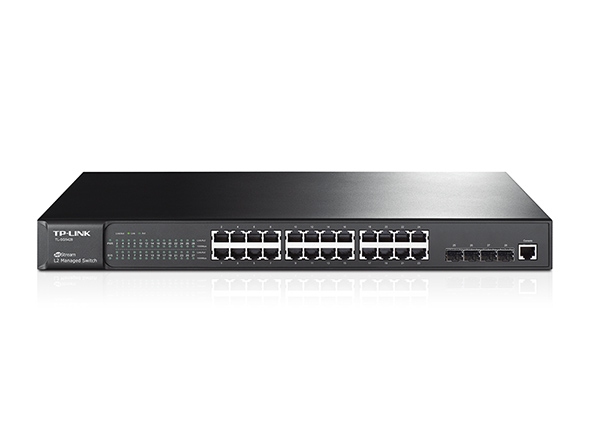TL-SG5428
JetStream 24-Port Gigabit L2 Managed Switch with 4 SFP Slots
- ACL, 802.1X Authentication, Port Security, IP Filtering, Storm control, DHCP Snooping, IP Source Guard and DoS Defend provide you robust security strategy
- L2/L3/L4 QoS and IGMP snooping optimize voice and video application
- Single-IP-Management supports virtual stack of 32 units
- SNMP, RMON, WEB/CLI/Telnet Log-in bring abundant management policies
What This Product Does
High Switching Capacity
TP-LINK’s L2 managed switch TL-SG5428 provides non-blocking switching solutions for gigabit connections and switching capacity with a non-blocking aggregated bandwidth of 56Gbps. It provides 24 gigabit ports and 4 SFP slots. With this high switching capacity, TL-SG5428 can markedly enhance your network throughput.
Virtual Stackable
Comprehensive Security Strategy
Moreover, the TL-SG5428 switch supports 802.1X authentication, which is used in conjunction with a RADIUS server to require some authentication information before access to the network is allowed. And more, it supports Guest VLAN to enable the non-802.1X clients to access the specific network resource. In addition,IP-MAC-Port-VID Binding, Port Security, Storm control, DHCP Snooping and IP Source Guard support can protect against broadcast storms, ARP and Denial-of-Service(DoS) attacks, etc. Regarding to the DoS defending, TL-SG5428 provides you some typical DoS attacks to select. You can protect these attacks more easily ever than before. TL-SG5428 will provide you robust security to the network.
Enterprise Level Manageability and Resiliency
TL-SG5428 supports various user-friendly standard management features, such as intuitive web-based Graphical User Interface (GUI) or industry-standard Command Line Interface(CLI), either administration traffic can be protected through SSL or SSH encryptions. SNMP (v1/2/3) and RMON support enables the switch to be polled for valuable status information and send traps on abnormal events. This sharing of vital management information saves time and money. With link aggregation, spanning tree protocol (STP/RSTP/MSTP) and virtual stack, a highly intelligent and scalable topology could be established, fulfilling the enterprise customers´ requirement of building a unified, resilient network.









